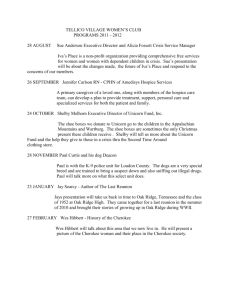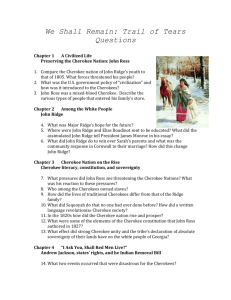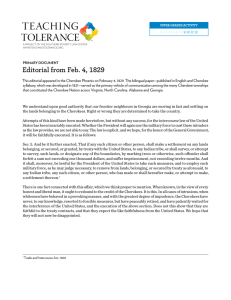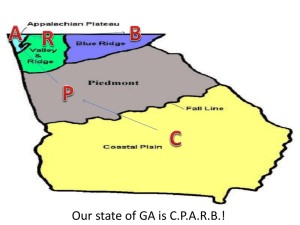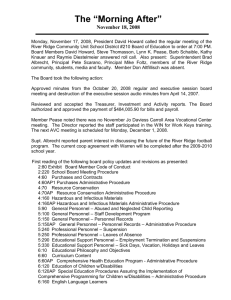Murder on Honey Creek
advertisement
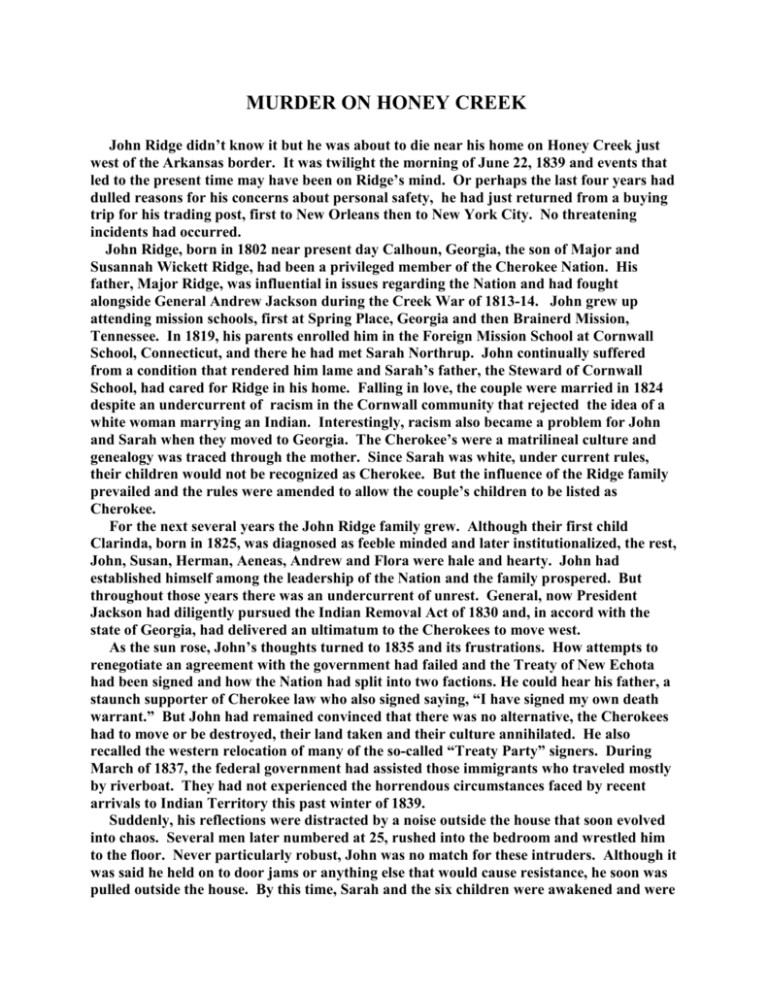
MURDER ON HONEY CREEK John Ridge didn’t know it but he was about to die near his home on Honey Creek just west of the Arkansas border. It was twilight the morning of June 22, 1839 and events that led to the present time may have been on Ridge’s mind. Or perhaps the last four years had dulled reasons for his concerns about personal safety, he had just returned from a buying trip for his trading post, first to New Orleans then to New York City. No threatening incidents had occurred. John Ridge, born in 1802 near present day Calhoun, Georgia, the son of Major and Susannah Wickett Ridge, had been a privileged member of the Cherokee Nation. His father, Major Ridge, was influential in issues regarding the Nation and had fought alongside General Andrew Jackson during the Creek War of 1813-14. John grew up attending mission schools, first at Spring Place, Georgia and then Brainerd Mission, Tennessee. In 1819, his parents enrolled him in the Foreign Mission School at Cornwall School, Connecticut, and there he had met Sarah Northrup. John continually suffered from a condition that rendered him lame and Sarah’s father, the Steward of Cornwall School, had cared for Ridge in his home. Falling in love, the couple were married in 1824 despite an undercurrent of racism in the Cornwall community that rejected the idea of a white woman marrying an Indian. Interestingly, racism also became a problem for John and Sarah when they moved to Georgia. The Cherokee’s were a matrilineal culture and genealogy was traced through the mother. Since Sarah was white, under current rules, their children would not be recognized as Cherokee. But the influence of the Ridge family prevailed and the rules were amended to allow the couple’s children to be listed as Cherokee. For the next several years the John Ridge family grew. Although their first child Clarinda, born in 1825, was diagnosed as feeble minded and later institutionalized, the rest, John, Susan, Herman, Aeneas, Andrew and Flora were hale and hearty. John had established himself among the leadership of the Nation and the family prospered. But throughout those years there was an undercurrent of unrest. General, now President Jackson had diligently pursued the Indian Removal Act of 1830 and, in accord with the state of Georgia, had delivered an ultimatum to the Cherokees to move west. As the sun rose, John’s thoughts turned to 1835 and its frustrations. How attempts to renegotiate an agreement with the government had failed and the Treaty of New Echota had been signed and how the Nation had split into two factions. He could hear his father, a staunch supporter of Cherokee law who also signed saying, “I have signed my own death warrant.” But John had remained convinced that there was no alternative, the Cherokees had to move or be destroyed, their land taken and their culture annihilated. He also recalled the western relocation of many of the so-called “Treaty Party” signers. During March of 1837, the federal government had assisted those immigrants who traveled mostly by riverboat. They had not experienced the horrendous circumstances faced by recent arrivals to Indian Territory this past winter of 1839. Suddenly, his reflections were distracted by a noise outside the house that soon evolved into chaos. Several men later numbered at 25, rushed into the bedroom and wrestled him to the floor. Never particularly robust, John was no match for these intruders. Although it was said he held on to door jams or anything else that would cause resistance, he soon was pulled outside the house. By this time, Sarah and the six children were awakened and were pleading with the attackers. But John Ridge was beyond help. Dragging their victim down a path a few yards, the assassins went to work beating, knifing and stomping on his body. This murder went beyond fulfilling the ancient Cherokee code that decreed anyone signing away Cherokee land would be killed, this had become personal. There is no doubt, that among the assassins were survivors of the recent “Trail of Tears” or that some were relatives of the estimated 4,000 who died on that journey. The forty eight stab wounds, the stomping on the body, and finally, the gash that slit his throat was mute evidence of the their pent up anger. It was soon discovered that the murder of John Ridge was an orchestrated attack on several who had signed the Treaty. That same day, John’s father, Major Ridge was accosted on a trail in eastern Arkansas and killed as was Elias Boudinet down at Park Hill. Some intended victims were spared. Stand Watie, Boudinet’s younger brother, also at Park Hill, was warned and escaped on Reverend Samuel Worchester’s horse. Others fortunate to survive were James Starr, John A. Bell and George W. Adair. The impact of the signing of the Treaty of New Echota has been debated ever since it occurred. Did it destroy the Cherokee Nation or save it? Was the fate of the tribe inevitably tied to the Indian Removal Act of 1830? Could it’s land have been preserved? Would the Cherokee tribe have lost its identity and been assimilated into white culture? Whether or not John Ridge and others who negotiated the treaty were correct in their assumptions remains the subject of debate. But beyond debate is the fact that Ridge and several others knew they were staking their lives on the decision. Some won, some lost. . .

